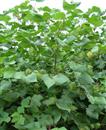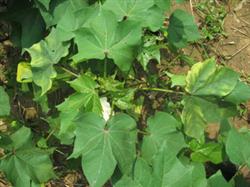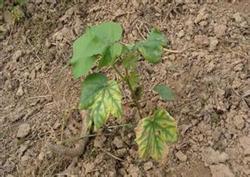Field Management Measures of Xiantao Cotton in Lower Stage

(1) the investigation results of Fu peach are as follows: the cotton planting area of professional cooperatives in the city is 104.38 million mu, the average density per mu is 1640, plant height is 134.9 cm, fruit branches are 19.7. there are 15.25,18.03,2.4flowers, 27.56buds, 11.81shedding, 17.66% (total fruit festival 66.85), 25010 peaches per mu and 19.4 autumn peaches per mu. It is estimated that the total number of peaches per mu in the whole year is 56826. Compared with the same period last year, this result shows "four increases, two decreases, one level and two declines". The fourth increase: the plant height increased by 0.2cm, the peach per plant increased by 10.6cm, the flower increased by 1.02, the bud increased by 6.08, and two decreased: the adult peach per plant decreased by 10.25cm, and the annual adult peach was expected to decrease by 5401 per mu; one flat: the number of fruit branches was the same; two decreases: the number of shedding per plant decreased by 13.88and the shedding rate decreased by 13.88%. (2) according to the analysis of the above survey results, the main reason why there are fewer cotton peaches this year than last year is that the sowing and transplanting period has been delayed, which has led to the postponement of the cotton growth process. Since August, cotton has grown steadily and has sufficient stamina. As long as the field management is strengthened and the weather is normal in the later period, a better harvest is expected. Looking at the growth of the field, the current situation of cotton production is not optimistic. Cotton in spring fallow land, oil stubble cotton and wheat stubble cotton are growing satisfactorily this year; however, due to insufficient investment in production, partial application of nitrogen fertilizer or insufficient fertilization, the shedding rate of cotton is high, and the trend of premature senescence is obvious. Insect pests such as Spodoptera litura, bug bug, cotton bollworm and red spider still occur seriously. (3) according to this year's fertility survey, according to an average of 125 peaches per jin of seed cotton and 38% lint percentage, the lint yield of the whole city is expected to be about 86.37 kg. At present, cotton field management should focus on protecting peaches, fighting for autumn peaches, striving for boll weight, and preventing rotten peaches. Specifically, the following five points should be grasped: 1. Active chemical control must be taken to control some fields to meet with fertilizer and water and grow vigorously. For cotton fields where there is no regulation or control is not in place after topping, 15-20ml / mu or 4-5g / mu of promethamine should be sprayed with 30kg water in the near future, which can effectively control invalid buds, reduce shade, enhance stress resistance and light transmittance of cotton plants, enhance photosynthesis and promote the transfer of nutrients to cotton bolls. 2. Thoroughly pruning and beating leaves continuously led to high humidity in the cotton field in August. In order to prevent rotten peaches in the lower part, empty branches, old leaves, sprouts were wiped out in the cotton field, and bystander was removed, so as to reduce the shade degree of the cotton field, improve the ventilation and light transmission conditions of the cotton field, and reduce the field humidity. 3. Extra-root topdressing of cotton is generally on the low side this year, so it is necessary to combine insect control with foliar spraying of 1% urea or 1% urea + 0.2% potassium dihydrogen phosphate mixture, once every 5-7 days, 3-4 times in a row. For serious boron deficiency fields, 0.2% powerful boron was sprayed to ensure the nutrients needed for the growth of cotton plants. 4. In order to control the spread of bacteria and reduce the degree of loss, it is necessary to pick dangerous peaches and rotten peaches in time when picking dangerous peaches and rotten peaches. 5. Comprehensive prevention of diseases and insect pests should set up the idea of resisting disasters and winning a bumper harvest. One is to clear the ditch and filter water to reduce the humidity in the field. The second is scientific pest prevention. According to different pest control standards, pesticides should be selected for timely prevention and control. At present, the focus of insect pests is Spodoptera litura, bug bug, the fourth generation of cotton bollworm, red spider and so on. At the same time, the prevention and control of other pests should not be ignored, and the pests should be eliminated in the early incubation period to ensure a bumper cotton harvest.
- Prev

How to control Verticillium wilt of cotton
The damage of cotton Verticillium wilt was mainly manifested in the middle and later stages of cotton growth. In July and August, the incidence of Verticillium wilt was light in the years of high temperature, drought and lack of rain in summer. Verticillium wilt is generally not dwarfed, but also can bear a small number of cotton bolls, flower and boll period after a long drought and heavy rain, the leaves suddenly wilted. It looks like a water stain, and then it falls off.
- Next

How to alleviate the "Cancer" of insect-resistant Cotton
Fusarium wilt of cotton is habitually called cancer by farmers. In fields where the disease has occurred, planting cotton later is often prone to cancer, or even more serious year after year, because once this kind of bacteria lurks in the soil, it is difficult to eradicate, and when it comes to suitable climatic conditions, it is easy to relapse. ...
Related
- The first cup of black tea in spring, the flavor and history of tea gardens in Kenya, Africa
- The computer can not only choose potatoes, but also grow tea rice. AI will grow winter oolong tea champion.
- It is not only the inflated tea bitten by insects, but also engraved with the four seasons tea in Beipu.
- The Oriental Beauty Tea Festival in Zhuxian County takes the stage at the weekend to experience the plus-size feast of oil tea.
- & quot; Oriental Beauty Tea & Exploration of Emei in Hsinchu, the hometown of quot;
- The new variety of strawberry "Tainong 1" dessert is the first choice with mellow aroma. Crimson gorgeous
- History of Tea in Taiwan: from Wild Inner Mountain to Export Tea Garden
- Two types of Taiwan Oriental Beauty Black Tea won the British three-Star Award for Childhood Tea Xiang Zhang Jiaqi changed from pilot to champion tea maker.
- Banana species and varieties: the planting history of Taiwan Xianren banana and dwarf banana is long, is banana disease resistant?
- Coffee planting Technology: Qianjie Coffee from Seedling to harvesting

